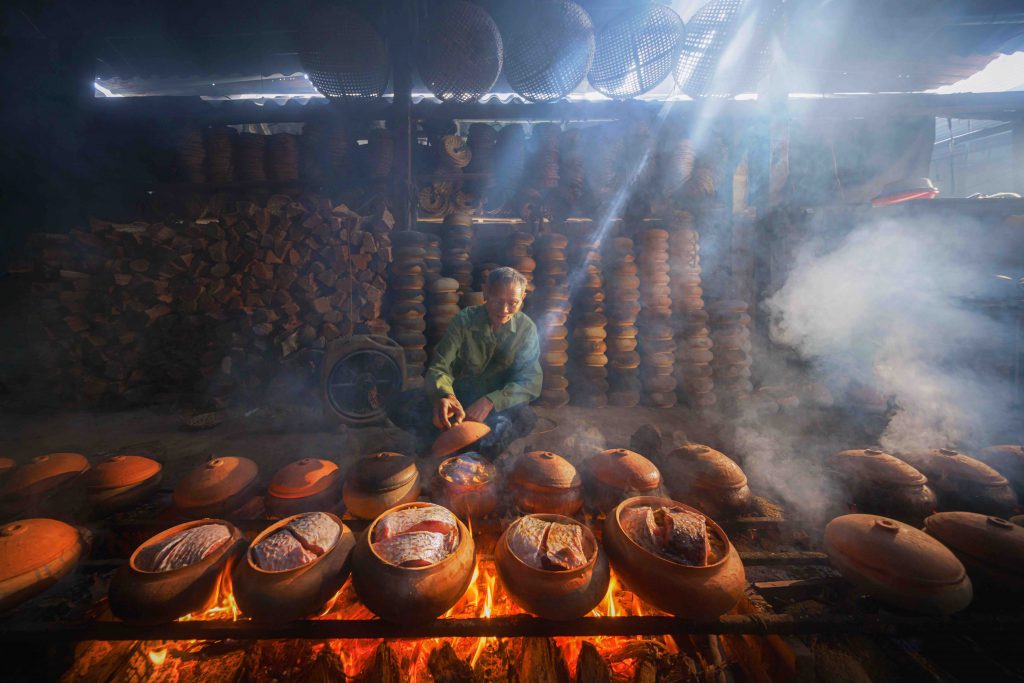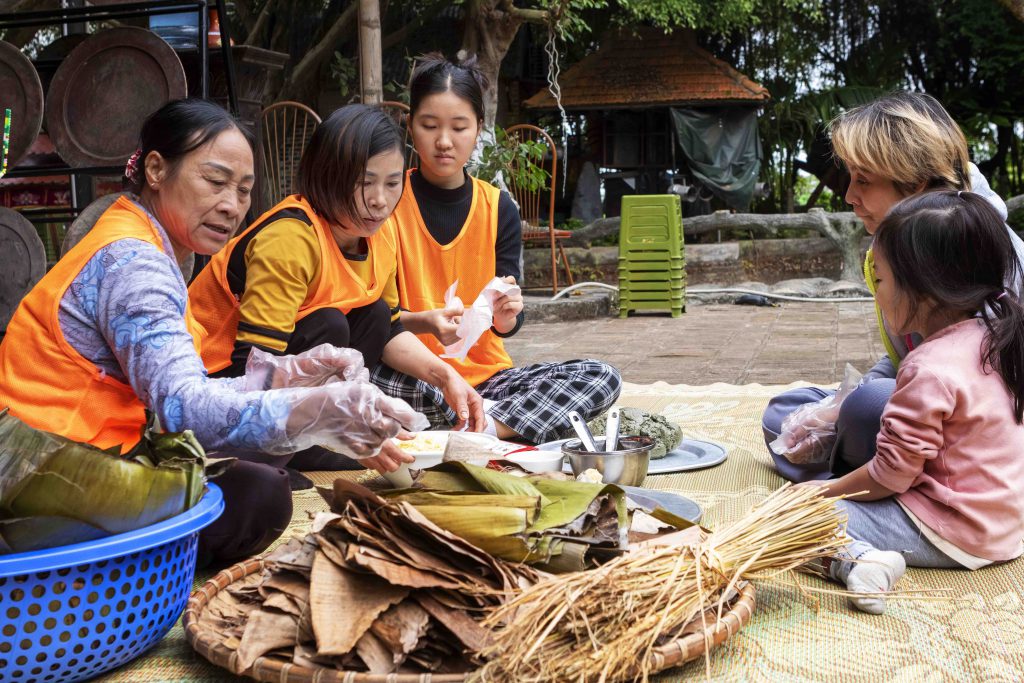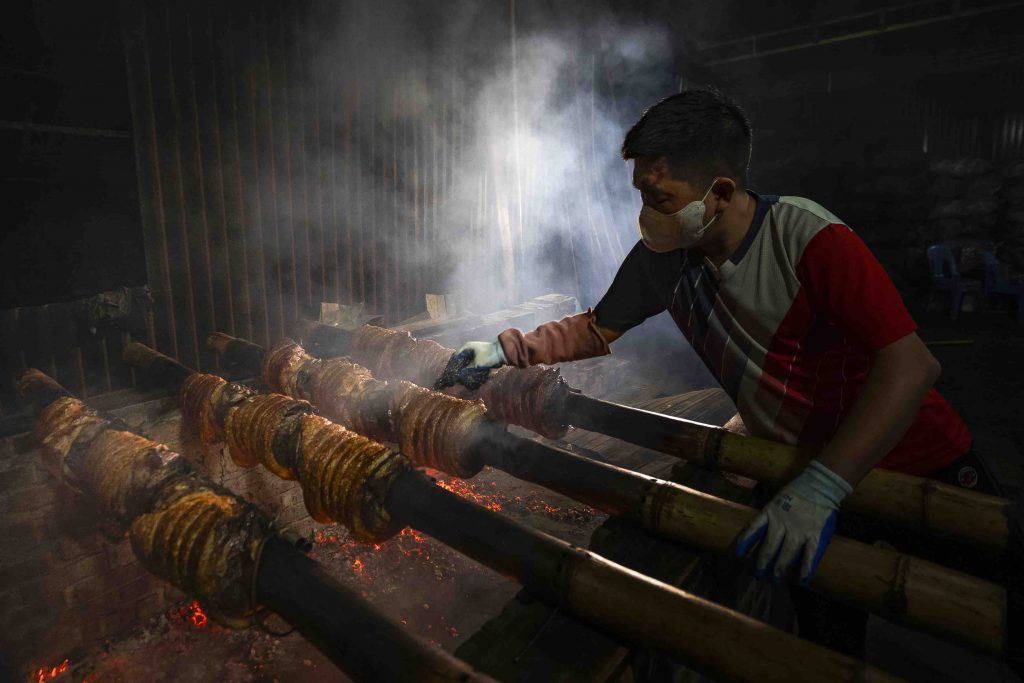Story: Long Tuyen
Photos: Vinh Dav, Nina May, Thai A
Cuisine is a key element of tourism, and when exploring Northern Vietnam, discerning travelers often share recommendations for delicious dining spots, interesting attractions, and prime locations for photos. Not only international visitors but also Vietnamese families and groups of young friends enjoy venturing into the countryside to enrich their cultural knowledge and enhance their life experiences, especially families with young children.

When discussing unique rural flavors, one must mention the braised fish dish from Vu Dai village (Hoa Hau commune, Ly Nhan district, Ha Nam). Known as “fit for kings,” this dish requires meticulous preparation. Ingredients include black carp weighing 4-5 kg or more, along with essential seasonings like fresh lemon, ginger, galangal, chili, pepper, and high-quality fish sauce.
The fish is carefully marinated before being placed in a clay pot and cooked over a charcoal fire made from longan wood. The cook must closely monitor the stove to maintain a stable temperature and time the addition of water to ensure the pot does not run dry. After simmering for 8 to 12 hours, the braised fish develops a fragrant aroma, firm texture, and an appealing dark brown color. Today, Vu Dai braised fish is not only a local specialty served to guests within the village but has also gained popularity in many regions, becoming a cherished gift that carries the essence of home.

Rural rice-based meals in these villages possess distinctive flavors, especially evident during the Quan Ho meals served by the villagers of Lim and Diem (Bac Ninh).
In January and February, extending into March of the lunar calendar, a spring atmosphere still lingers over the homeland of Quan Ho songs, where enchanting singing sessions captivate hearts. Meals from Quan Ho village are renowned for their variety and intricate preparation. At the Luy Lau Cultural Heritage Preservation Area (Thuan Thanh district, Bac Ninh province), artisan Nguyen Thanh Lai organizes programs where guests can learn how to make banh chung (square sticky rice cakes), banh gai (leafy sticky rice cakes), and banh nep (sticky rice cakes) before enjoying a rural meal.
This meal includes dishes like boiled chicken, fried spring rolls, and crab soup. Enjoyed in an ancient house with lim wood pillars, tiled roofs, red-brick courtyards, and framed Dong Ho paintings, diners feel connected to the region’s rural roots.

In Duong Lam village, located about 40 km from Hanoi, the culinary experience takes on a unique meaning, reflecting the essence of the ancient village. Alongside Mia Pagoda and Va Temple, dedicated to Saint Tan Vien, Duong Lam ancient village stands as a living fossil of Northern architecture from the 18th-19th centuries. Visitors can immerse themselves in the historic atmosphere, with traditional houses featuring three or five compartments and two wings, brick gates covered in lush foliage, and cobbled village paths.
The rice dishes from Duong Lam entice diners with a variety of rural specialties, including fried tofu dipped in soy sauce stored in jars kept outside in the yard, refreshing crab soup with Malabar spinach and water spinach, and the renowned roasted pork with crispy skin, visually appealing with its deep gold color.
The main ingredient is three-layered pork, marinated with a secret recipe and finely chopped young guava leaves before being wrapped in bamboo sticks and grilled over charcoal for about six hours. After enjoying rice with various specialty dishes, villagers introduce guests to the process of making che lam (a type of sweet cake) and invite them to taste this rural treat along with fresh tea. Guests from afar are touched by this simple hospitality.
The old scents and flavors of Northern Vietnam remain. Although ancient villages have changed and traditional tiled roofs are becoming scarce, deep within rural life a stream of culinary culture has been passed down through the generations. These familiar flavors remind us of our roots and traditions so that no matter where we go, we will always remember home.










